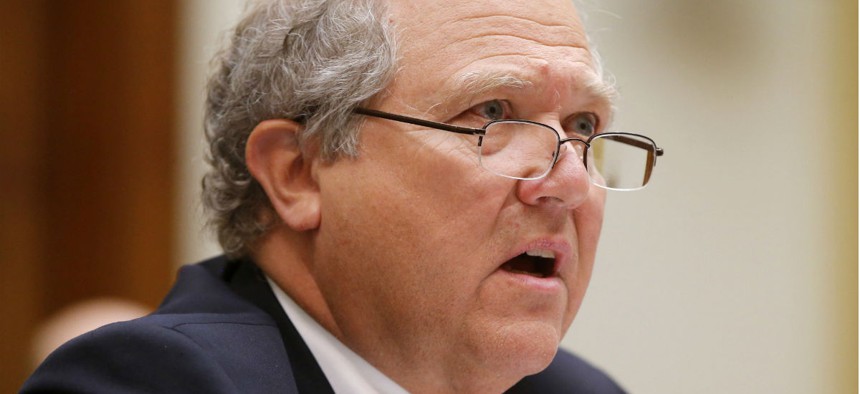
Special Inspector General for Afghanistan John Sopko Charles Dharapak/AP file photo
Fate of Afghanistan Hinges on Donor Funds, Watchdog Warns
Inspector general’s "high-risk" report urges planning for major future expenditures.
If and when negotiators reach an accord with the Taliban to pacify Afghanistan, the United States and international donors should be ready to plan for years of continued funding of a government in Kabul still shaky after 18 years of the U.S.-led coalition’s war.
So warned John Sopko, the special inspector general for Afghanistan reconstruction, to mark the release on Thursday of his third “High-Risk List” outlining eight key challenges to the continuing U.S. presence in the war zone that has cost Americans 2,400 service members’ lives and $780 billion.
“If a peace agreement is reached and U.S. and coalition forces leave,” Sopko told a Washington audience at the Center for Strategic and International Studies, “policymakers should not forget that the Soviet-installed Afghan government did not collapse upon the [1988] withdrawal of Soviet troops, but only later, after financial support ended.”
Without sufficient funds from U.S. allies and international financial institutions, “the government of Afghanistan cannot survive,” said Sopko, now in his seventh year as an outspoken SIGAR. “Should peace come, if that peace is to be sustainable, it will come at an additional price that only external donors can afford.”
SIGAR’s latest high-risk list (the first came out in 2014), which focuses on reconstruction and not combat, lays out eight risks that “might persist or arise in the wake of any peace agreement: widespread insecurity, underdeveloped civil policing capability, endemic corruption, sluggish economic growth, illicit narcotics trade, threats to women's rights, reintegration of ex-combatants, and restricted oversight.”
Issues such as government graft, the ancient opium trade and persistent poverty have been addressed in dozens of SIGAR reports. But some of risks on the new list “may persist, be magnified, or emerge despite—or even because of—a peace deal,” Sopko said.
For example, “There are over 300,000 Afghans currently serving in the security forces, most of whom are armed,” he told the audience. “If, because of a loss of financial support, their paychecks were to stop coming, this could pose a serious threat to Afghanistan's stability. Similarly, a failure to peacefully reintegrate as many as 60,000 heavily armed Taliban long-term would threaten any peace agreement as disaffected former Taliban who may have been expecting a peace dividend may return to violent and predatory behavior.”
The threatened Afghan government also needs to pay for health clinics, schools, water and power infrastructure and roads to achieve legitimacy, Sopko noted.
Though the rebuilding effort has shown progress in improving the lives and rights of women in a country long-dominated by Islamic traditions, the report warned that “a return to systematic repression of Afghan women would quickly diminish congressional and public support for continued assistance to Afghanistan and, in the process, threaten any government reliant on that support.” Women occupy 63 seats out of 320 in the Afghan parliament, and have achieved a major presence in such occupations as judges, teachers, police and medical providers, he said.
However, “There are also misconceptions about how much progress actually has been made—particularly for women living outside of Kabul,” he said, announcing that a new report on women’s progress is coming.
In fiscal 2019, donor countries are expected to provide about 51 percent of the Afghan government’s $5.6 billion budget, with about 15 percent going to reconstruction, the report noted. But the Defense Department estimates security funding requirements for Afghanistan for the year to be about $6.5 billion, of which the U.S. Congress is providing $4.9 billion.
The government’s capabilities are weak, so “there may be little choice but to provide a greater proportion of funding as on-budget assistance,” the SIGAR said, noting that on-budget spending requires greater oversight. “But if that road is taken and conditions are lacking, we may as well set the cash ablaze on [Kabul’s] Massoud Circle for all the good it will do.”
SIGAR is working on a new report on “lessons learned” from past reintegration efforts in that country and elsewhere. But, “as an inspector general, I cannot countenance throwing taxpayer money blindly in any direction, no matter how righteous the cause,” Sopko said.
He said his team has “good relations with the current government,” and has won access to bank records and even had a SIGAR employee testify in court in an embezzlement case, a rarity.
International donors such as the World Bank and the United Nations, he added, “have had serious problems monitoring the funds they disburse. Further, U.S. agencies have shown very little inclination to monitor what the funds’ financial agents are doing.”
During questioning, Sopko offered praises for Mark Green, the new administrator of the U.S. Agency for International Development (the target for much criticism in past SIGAR reports). USAID has been “racking and stacking” programs with an eye toward cutting the “useless” ones to spend less money on “frills,” he said. The key to Afghanistan’s postwar future, Sopko argued, will be economic development.







